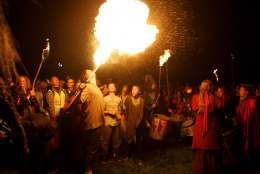

Celts believed it was a time where the boundary between the world of the living and the world of the dead became blurred.
They wore costumes and lit fires in the fields to celebrate.
(AP Photo)
AP Photo

(AP Photo)
AP Photo

WTOP/Mike Jakaitis

Eventually, the Catholic Church declared Nov. 1 All Soul's Day, a time to honor martyrs and saints.
The feast day was later changed to Nov. 2, and is largely thought to have been implemented to replace the pagan Samhain.
(AP Photo)
AP Photo

Halloween was largely restricted to Maryland and Southern colonies.
(AP Photo)
AP Photo

Americans took a cue from their Irish and English neighbors and starting wearing costumes to celebrate.
(AP Photo)
AP Photo

AP Photo

(AP Photo)
AP Photo
When he finally died, neither God nor Satan would accept him.
Trapped in Limbo, Jack was eventually given a lump of coal that he put inside a carved turnip to light his path while he endlessly wandered Earth.(AP Photo)

Aztecs had their own version of Samhain, but it was not celebrated at the end of October. Their feast was a month-long ritual that fell on the ninth month of the Aztec calendar, which would coincide with August.
The Spanish conquistadors moved the Aztecs' festivities to coincide with the Catholic All Souls' Day as a way to indoctrinate the natives.
Today, Dia de los Muertos is celebrated throughout Mexico and parts of Central America. It is not a time of mourning but a time of celebration -- to the Aztecs, death was not an end but merely a change.
(AP Photo)
AP Photo

















